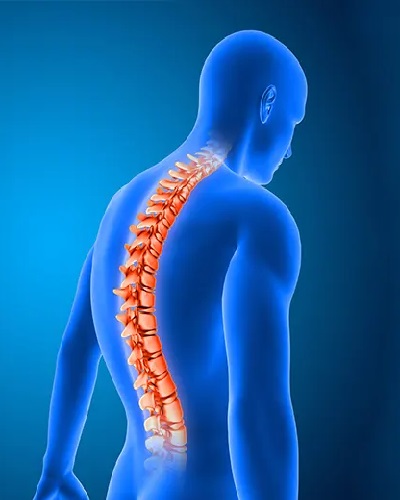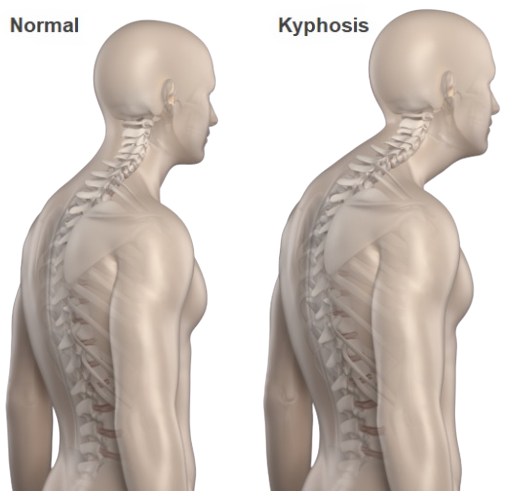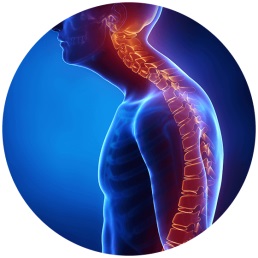Kyphosis Symptoms & Treatment Options
Kyphosis is one of the most common spinal deformities defined as an abnormal, forward curvature of the thoracic spine distinguishes this condition from other spinal deformities. (Scoliosis, for example, involves an abnormal, lateral (or sideways) curvature in the thoracic and/or lumbar spine.) For this reason, people sometimes refer to this disorder as hunchback or hump back. And, while we do not use these terms in practice, kyphosis is most easily identified by the hunched over posture that it creates.
Specifically, your thoracic spine composes the portion of spine located between your neck and the lower back. From a functional perspective, your thoracic spine supports your rib cage and protects your vital organs—like the heart and lungs. Although genetically designed with a slight forward curvature, an exaggerated C-curve of the thoracic spine indicates kyphosis.
In addition, this condition affects older adults—especially older women—more frequently than other populations. Progressive, age-related conditions such as osteoporosis, degenerative spondylolisthesis, and osteoarthritis contribute to these spikes in prevalence. However, kyphosis can occur at any time in life for a number of reasons. And, regardless of your age, a variety of troubling symptoms may be present.
Symptoms of Kyphosis
When kyphosis first sets in, you may not notice the external (and internal) side effects. Depending on the individual, further progression of the curve may halt naturally or through a variety of applied interventions. If the condition progresses, however, the C-curve of the spine will continue to exaggerate. Moreover, this will lead to an increased probability that concerning symptoms will arise. Pain that increases with activity or at the end of the day to progressive and constant is one of the main symptoms referred by patients with kyphosis.
Worried that you might be suffering from a spinal deformity? Don’t delay your decision to contact us, today! Our seasoned clinicians will evaluate the health of your spine, provide thorough feedback, and deliver minimally invasive treatment options.
Types of Kyphosis
In addition, subtypes of kyphosis may include:
Postural: Caused by slouching or poor posture, this type of kyphosis emerges primarily in adolescents, teenagers, young adults, or desk workers. Weak muscles in the back combined with poor posture often causes this form of kyphosis. However, postural kyphosis does not typically leave lasting health problems. You can often remedy this condition through education about proper posture and strength-building exercises that tighten the back and core.
Degenerative: One of the main causes of kyphosis, degeneration of the spine leads to tissue breakdown, reduction of the space between vertebrae, and spinal deformities. An age-related condition, degenerative kyphosis correspondingly worsens with conditions such as osteoporosis, arthritis, or spinal stenosis.
Scheuermann’s: The precise cause of Scheuermann’s Kyphosis is still under study and debate. Researchers believe that a genetic predisposition may lead to improper spinal growth during the adolescent and teenage years. Further, researchers speculate that this abnormal development leads to a rapid loss of cartilage, as well as wedge-shaped vertebrae. In combination, these factors contribute to the 45 to 70-degree curvature that defines this condition. Disputed causes include loss of blood flow to the cartilage (precipitating cartilage loss), mild osteoporosis, and muscle irregularities.
Post-Surgical: Not a particularly uncommon occurrence, spine surgery to fix other spine conditions can sometimes lead to post-surgical kyphosis. New areas of weakness and instability caused by subtractive surgeries, such as microdiscectomies, osteotomies, and foraminotomies, can cause this.
Congenital: Less common but no less severe, congenital kyphosis results from a genetic error that affects the development of the spine in utero. Of particular significance, this disorder leads to the most cases of kyphosis-related paralysis that did not result from a traumatic injury. In addition, researchers have determined that this condition often co-occurs with disorders of the urinary collection system, primarily the kidneys.
If You Or Someone You Know Is Experiencing Abnormal Thoracic Curvature, Symptoms May Include:
- You may feel pain local to the abnormal arch in spine
- Local discomfort may be especially intense if fractures and/or pinched nerves are present
- Pain may also radiate down the back or out to the shoulders
- The hamstrings may stiffen as they compensate for the forward pull of the upper back
- The head may progressively pitch forward, hindering your ability to walk or drive
- Extreme curvature may compress the heart & lungs, interfering with cardiac function
- In severe cases, compression of the spinal cord can cause loss of sensation or immobility
More about Dr. Matin
Kyphosis Symptoms & Treatment Options
Kyphosis pain can be treated by Dr. Martin, give us a call to schedule an appointment.
We will provide different options of treatment.
Conservative Treatments
Conservative treatments to address mild kyphosis may include: kyphosis bracing; visiting a physical therapist to work on strength-building exercises; lessons in maintaining healthy posture; and/or NSAID medications to reduce pain and inflammation.
Osteotomy
An Osteotomy involves reconstructing the spine by removing slivers of adjacent vertebrae. This process alters the angles between spinal vertebrae, decompresses the heart and lungs, and restores the curvature of the spine as a whole.
Kyphoplasty
Used to restore vertebral height when fractures are present, a kyphoplasty involves the insertion of a balloon into the collapsed vertebra. Once the balloon is inflated, your doctor will inject a fast-drying cement into the vertebral body to reinforce the spine.
Spinal Fusion
Spinal fusions are techniques that use screws and rods to correct the posture of the spine or correct severe spinal curvature. More specifically, post-surgical or degenerative kyphosis may require this specialized form of surgical intervention.






